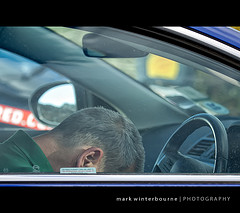
flickr.com/lbaviation
Does someone in your house experience sleep apnea? If yes, you’ll know it. On the surface, sleep apnea can look just like a hefty bout of snoring. However, the long-term effects can be devastating.
A lot men, women and even children suffer from sleep apnea without even realizing it. When people with apnea fall asleep, the muscles in the upper part of the airway begin to collapse on themselves. This can be usually the result of a number of underlying conditions. For example, being overweight can cause muscles and tissues in the airway to become flabby. The airway becomes obstructed, causing the person to actually stop breathing for a few seconds. When the brain kicks into action, the breathless sleeper awakes with a loud snort or snore, gasping for air. It’s a bothersome and frightening condition for both the person suffering apnea, and those sleeping near by.
Several instances of apnea can strike during the night, and some people can experience apnea dozens of times in a single night. The sleep pattern is, of course, incomplete, and it is virtually impossible for him or her to reach a proper state of REM sleep. When daytime comes, she or he will be cranky, drowsy and ineffective. The indications of sleep apnea can range from the seemingly minor, to those that are quite relentless and even threatening.
Apnoea — Hypopnoea Index
If you know that you, or your partner, suffer with sleep apnea that should be monitored and controlled, there is an index that can be utilized. Called the Apnoea-Hypopnoea Index, this formula is used to find out the severity of the problem. Hypopnoea is the phrase used for the reduction of airflow passing through the airways. Using this index, the number of apnea attacks is established, along with the number of hypopnoeas. A scale is then used to determine the severity of the problem.
Apnoea — Hypopnoea Scale
When the data has been plotted, your doctor will be able to assess your AHI (Apnoea-Hypopnoea Index) results, using the Apnoea-Hypopnoea Scale.
AHI less than 10: This score suggests that the extent of the apnea problem probably does not have any underlying medical conditions. With this information in hand, the individual suffering apnea can stop worrying about possible health threats, and begin focusing on a way to stop the snoring.
AHI above 10: A person displaying this score should be concerned about underlying medical problems. If you present with an AHI score over 10, you might take into consideration being part of a specialized sleep study. You’ll be asked to spend the night in the hospital, where special equipment will be used the monitor the quality, amount, and type of sleep you are getting. If the study reveals that you are being deprived of oxygen in your sleep, you could be at risk of stroke, cardiac problems, or Adult Sudden Death Syndrome.
There are a few methods of treating sleep apnea. In severe cases, an oxygen mask is worn to bed, offering a steady stream of oxygen to keep the airways open throughout the night.
If you, your partner or child may be experiencing sleep apnea, don’t take unnecessary dangers. See your doctor and ask to discuss with a sleep disorder specialist. Use the Apnoea-Hypopnoea Index and Scale to assess the situation, and then you can find the solution. Of course, you’ll all sleep happily ever after.
Sleep better! Check out the world's Best MATTRESS TOPPER.
Which one of these is this the world's best foam mattress?
Candidate "A"
Candidate "B" -- you decide 🙂
Tagged with: sleep apnea • snore
Filed under: Sleep Apnea